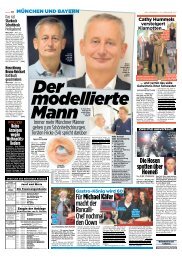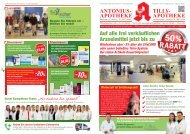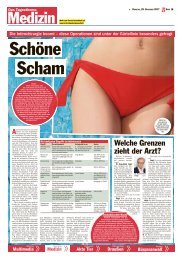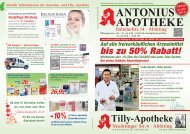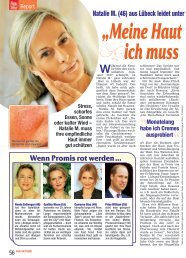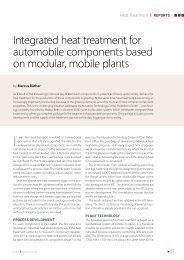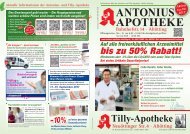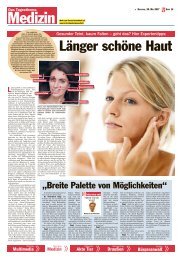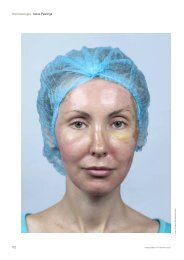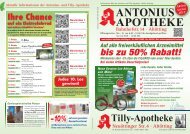hp_032017_FB_Ruether
Create successful ePaper yourself
Turn your PDF publications into a flip-book with our unique Google optimized e-Paper software.
Heat Treatment<br />
REPORTS<br />
Integrated heat treatment for<br />
automobile components based<br />
on modular, mobile plants<br />
by Marcus Rüther<br />
As a result of the increasingly intensive use of aluminium components in present and future automobiles, demand for<br />
heat treatment for the production of these components is growing. At the same time, heat treatment is becoming an<br />
increasingly important process step because of the growing demands posed by more and more complex component<br />
properties. This is the challenging situation addressed by Aluvation Technology Center Paderborn GmbH – a technology<br />
company founded by Markus Belte in October 2016 – with its Aluvation system, which reinterprets integrated heat<br />
treatment by offering a complete package for the treatment of automobile components. The package includes process<br />
development and the supply of the treatment plant as well as data logging and processing.<br />
It was the road transport involved in conventional<br />
approaches that initially suggested the idea for this<br />
reinterpretation. Aluminium components are normally<br />
cast at one location, shipped to the treatment contractor,<br />
heat-treated, and then loaded onto a truck for shipment<br />
to the machining plant. The road haulage costs involved<br />
are significant. Furthermore, capital is tied up in the interim<br />
storage which is required at each location involved in order<br />
to safeguard the process chain. The mobile plant modules<br />
of the Aluvation system provide a radical solution which<br />
reduces these costs.<br />
With the system, the heat treatment stage in the production<br />
process may be completed either at the foundry<br />
or at the plant where the parts are machined. Whichever<br />
location is selected, neither separate heat treatment knowhow<br />
nor data storage and analysis capacities are required<br />
as these are included in the overall package provided by<br />
Aluvation. There is no need to transfer the parts to a conventional<br />
heat treatment plant and all the costs connected<br />
with such shipping operations are saved.<br />
PROCESS DEVELOPMENT<br />
For each component to be treated, the first step is to<br />
develop an individual heat treatment process. If the heat<br />
treatment contractor is involved in component development<br />
from an early stage, the treatment process can already<br />
be taken into consideration in component design. For this<br />
purpose, the Aluvation Technology Center (ATC) in Paderborn<br />
offers the possibility of developing individual heat<br />
treatment processes at an early stage. These processes<br />
are developed on standardized plants, which means that<br />
the entire process including the equipment required has<br />
been reliably defined by the time when the design phase<br />
for a component is completed.<br />
The entire process, from solution annealing, quenching<br />
and age hardening through to straightening and testing,<br />
is developed on ATC treatment plants. At the same time,<br />
the charge carriers, which have considerable impact on the<br />
treatment process and the deformation of components, are<br />
also developed at the ATC. The aluminium components are<br />
already treated on the near-series plants at the ATC during<br />
process development. This constellation ensures that the<br />
results are reproducible.<br />
The results obtained are then validated in the ATC laboratory.<br />
The direct, continuous monitoring of series production<br />
is therefore already possible in the run-up phase.<br />
PLANT TECHNOLOGY<br />
The Aluvation approach to heat treatment is based on a<br />
standardized system of mobile modules. It is therefore<br />
possible to assemble production plants adapted to the<br />
individual process required by combining different modules.<br />
The dimensions of the charge carriers (1,700 mm x<br />
1,700 mm x 1,700 mm) are always the same while all the<br />
3-2017 heat processing<br />
83
REPORTS<br />
Heat Treatment<br />
Parts/Day<br />
7000<br />
6000<br />
5000<br />
4000<br />
3000<br />
2000<br />
1000<br />
0<br />
2014 2016 2018 2020 2022 2024 2026<br />
Fig. 1: Daily production run-up curve for components<br />
Production year<br />
other parameters can be adapted to the individual process<br />
or charge material.<br />
The individual modules are designed and installed as<br />
containers which are suitable for road haulage, allowing the<br />
highest possible degree of flexibility in plant deployment.<br />
The furnace modules are designed and produced by Tenova<br />
LOI Thermprocess GmbH. They consist of roller hearth<br />
furnaces which can be operated both as batch-type and<br />
as continuous treatment furnaces. The electrically heated<br />
furnaces feature highly homogeneous air recirculation with<br />
specially developed air guide systems.<br />
As the plant components and modules used are always<br />
the same, virtually any module can be combined with any<br />
other module. This means that the capacity of the plant<br />
can be flexibly adapted to the production volume actually<br />
required at any time.<br />
It is possible to start with a small plant, e. g. a chamber<br />
furnace, and then to adapt to changed requirements as a<br />
result of growing production volumes by installing additional<br />
modules.<br />
This plant technology means that aluminium components<br />
can already be produced at an early stage, during<br />
process development, as individual parts or in small series<br />
using plants of the same types that are later to be used<br />
for production.<br />
The development of the plant and the relevant cost<br />
always reflect actual demand. This means that the plant can<br />
be extended in stages during the ramp-up phase and gradually<br />
reduced in size when production is declining (Fig. 1).<br />
Furthermore, the modules can be relocated within the<br />
Planned<br />
Forecast<br />
production flow at any time<br />
as they are not connected to<br />
building systems. This relocation<br />
may be necessary if<br />
Actual<br />
additional process steps are<br />
added or deleted, requiring<br />
a reconfiguration of the production<br />
plant.<br />
The modules available<br />
include several furnace modules,<br />
an air quench module<br />
and a media quench module.<br />
The conveyor systems<br />
are configured in accordance<br />
with site requirements for<br />
production. Various different<br />
conveyor modules are available<br />
and special individual<br />
solutions can be added as<br />
necessary.<br />
The furnace modules<br />
(Fig. 2) mainly consist of the<br />
furnace casing with insulation<br />
including heating, air recirculation and conveyor systems<br />
and switchgear. There is an inlet and outlet module<br />
with a door on one side which is open on the other side<br />
and a chamber module which is designed as a complete<br />
compact furnace.<br />
The air quench module is installed complete with air<br />
supply, conveyor system, switchgear and silencers. It is a<br />
self-contained unit which can also be installed in a production<br />
line.<br />
The media quench module (Fig. 3) consists of three<br />
units, the tanks, the pump unit and the conveyor system.<br />
The media quench module is also designed so that the<br />
solution annealing furnace can be installed in a raised position<br />
above the quench.<br />
All the modules are simply installed on the plant floor<br />
and no special foundations are needed. The modules can<br />
be positioned and commissioned within the space of a few<br />
days. As process development is completed in advance<br />
and standardized modules are used, the running-in phase<br />
which is required for fine tuning process parameters with<br />
conventional plants can be omitted. It is only necessary<br />
to finalize the interaction of the modules with the local<br />
production facility.<br />
Fig. 4 shows a chamber furnace module (550B). This is<br />
designed as a compact furnace and includes air recirculation,<br />
heating and conveyor systems as well as a switchgear<br />
assembly. The roller table upstream from the furnace is<br />
used for charging and discharging. Both units are delivered<br />
to the site as complete modules. Only the recirculation fans<br />
are removed for shipment and packed separately.<br />
84 heat processing 3-2017
Heat Treatment<br />
REPORTS<br />
The furnace consists of three zones, each of which can<br />
accommodate one charge carrier. Each zone is equipped<br />
with a recirculation fan and can be controlled and heated<br />
individually. The roller table upstream from the furnace<br />
is designed so that a fork-lift truck can be used for material<br />
handling and for the charging and discharging of the<br />
furnace in batch operation.<br />
CHARGE CARRIERS<br />
Even though the dimensions of the charge carriers are<br />
defined by the furnace modules, the carriers still offer<br />
a wide variety of design options and allow the installation<br />
of specific internal for the parts to be treated. These<br />
are adapted to the size and shape of the individual<br />
parts. Only the external dimensions of the charge carriers<br />
and the design of the bottom, which is important<br />
for handling, are fixed. The charge carrier has a size of<br />
1,700 mm x 1,700 mm x 1,700 mm.<br />
The charge carriers may form a complete unit or consist<br />
of several carriers positioned in a stack, provided that<br />
the height does not exceed the maximum charge carrier<br />
height of the furnace.<br />
There are no limits to the individual design of component<br />
mounts. The nozzle arrangements in the furnace and<br />
the air quench as well as the media quench are designed<br />
to allow the treatment of parts with a very wide range of<br />
shapes and sizes.<br />
Especially in the case of the heat treatment of structural<br />
components, the development of the charge carriers is a<br />
key factor as the proper positioning of the parts minimizes<br />
deformation during treatment. This allows subsequent<br />
straightening work to be substantially reduced.<br />
The individual charge carriers must be designed in such<br />
a way as to support sensitive parts of the component and<br />
to take account of effects from the casting process.<br />
All charge carriers are designated using an unambiguous<br />
code to identify the carrier itself and the componentspecific<br />
internals used. This allows the tracing and recording<br />
of the charge carrier and the charge. The heat treatment<br />
programme used is adapted to the charge carrier and the<br />
charge. If the charge on the incoming charge carrier is not<br />
suitable for the heat treatment process currently selected,<br />
the furnace can refuse to receive the charge carrier.<br />
DIGITAL TRANSFORMATION<br />
The innovative approach of the Aluvation system includes<br />
a complete package of process development, process control,<br />
plant design, plant supply and plant monitoring. Relayr<br />
GmbH, Munich, Germany, has been included as a process<br />
partner which develops a special system for plant moni-<br />
Fig. 2: Basic furnace module<br />
3-2017 heat processing<br />
85
REPORTS<br />
Heat Treatment<br />
Fig. 3: Heat treatment line assembled from modules, with media quench<br />
toring. This allows the individual predictive maintenance<br />
of plants, supports the holistic approach and facilitates<br />
integrated data handling. The Relayr modules can be used<br />
with any plant. They ensure that deviations between the<br />
required and actual data of plants installed throughout the<br />
world can be recorded and analyzed at a central location.<br />
Modules are monitored directly at the Aluvation Technology<br />
Center (ATC) in Paderborn. The process documentation<br />
required is produced centrally, processed and made<br />
available to the respective recipients in digital form. This is<br />
in line with the approach of Industry 4.0, which paves the<br />
way for the digital orientation of future production facilities.<br />
Thanks to the central storage of data and treatment<br />
programmes, process adjustments which may be required<br />
during production can be made on a specific date for all<br />
identical components, even at short notice. This also applies<br />
if Aluvation plants are used for heat treatment at various<br />
locations throughout the world.<br />
Fig. 4: Photo of a 550B chamber furnace module<br />
MOBILE HEAT TREATMENT<br />
Aluvation therefore offers tailor-made solutions for the<br />
heat treatment of all aluminium components using mobile<br />
plants. Thanks to central plant and process monitoring,<br />
no process documentation infrastructure is required at<br />
the installation sites of the plants. All the data can be collected<br />
centrally, processed to generate batch reports and<br />
transferred to the respective recipients, such as car makers,<br />
in digital form.<br />
The integrated modular design of the plants means that<br />
it is possible to produce pre-series parts or to meet peak<br />
production demand using other plants or at provisional<br />
installation sites at the same time as ensuring compliance<br />
with process requirements.<br />
As soon as the production volume for a customer order<br />
calls for an independent production plant, this plant can<br />
be installed directly next to the foundry, e. g., and heat<br />
treatment can be carried out on site without further preparatory<br />
stages or the specific development of the heat<br />
treatment process.<br />
As a result of central data logging and the use of identical<br />
modules, treatment can be carried out at any location<br />
which may be required during the production of the<br />
components. For example, the treatment plant may be<br />
installed at the foundry, at the machining shop, at the surface<br />
treatment plant or at any other location on the route<br />
taken by the components.<br />
A FRANCHISE SYSTEM MAKES THE<br />
TREATMENT MOBILE<br />
The approach of the system in its entirety is not limited<br />
to the newly designed heat treatment process based on<br />
standardized, mobile modular units which can be used in<br />
flexible, variable configurations. Aluvation provides unique<br />
flexibility, allowing tailor-made cost-optimized services<br />
to be offered to customers in line with the increasingly<br />
stringent and complex requirements they face. In future,<br />
customers will be able to choose the solution which is ideal<br />
for them from a total of three options:<br />
■■<br />
If the production volume required still remains small,<br />
the customer can have heat treatment carried out on<br />
the equipment in the Aluvation Technology Center<br />
(ATC) in Paderborn.<br />
■■<br />
Customers can also opt for heat treatment at one of<br />
the Aluvation Centers (AC) which are being established<br />
throughout the world.<br />
86 heat processing 3-2017
Heat Treatment<br />
REPORTS<br />
■■<br />
If the production volume grows or high volumes or<br />
considerable flexibility are required from the start of a<br />
project, the modules required can be installed at the<br />
customer’s plant within 1–5 days. The customer has<br />
the modules installed at its own production facility and<br />
carries out heat treatment at its own location.<br />
For Aluvation, the main focus is on flexible, reliable service.<br />
This is why the company is currently developing a<br />
franchise system with a view to developing a global network<br />
of Aluvation Centers (AC) for heat treatment together<br />
with certified partners. Initially, there are specific plans to<br />
develop Aluvation Centers at several locations in Germany.<br />
Enquiries from India, the USA, Austria, Spain and Portugal<br />
are currently being processed and further centers are to<br />
be installed in other countries.<br />
The establishment and installation of Centers in Germany<br />
represents an exciting upgrade for existing surface treatment<br />
contractors. In discussions with aluminium coating<br />
companies, Markus Belte has found that companies which<br />
have only washed and coated aluminium components to<br />
date can extend their service portfolio in a meaningful way<br />
by offering heat treatment services. In combination with<br />
the modular Aluvation system, coating plants can become<br />
Aluvation Centers and round off their range of services by<br />
offering standardized heat treatment. This extension can<br />
be completed without investments, which could present<br />
an obstacle, at transparent rental conditions based on production<br />
volumes.<br />
STANDARDIZATION AS A KEY ELEMENT<br />
The standardization of modular plants and processes in<br />
combination with digital transformation represents the key<br />
element in the step forward to a new era in heat treatment.<br />
In order to create a system that was really new and<br />
innovative, Aluvation was based on the holistic analysis and<br />
integration of all the elements involved in a process. For<br />
the first time, a standard process was developed in which<br />
the process parameters for heat treatment are harmonized<br />
with the appropriate charge carrier. This means that, irrespective<br />
of where the customer produces its components<br />
and charge carriers, the plant, which has a standard design,<br />
will always receive the updated process parameters via<br />
a digitalized interface. This applies irrespective of where<br />
Aluvation plants are installed throughout the world. With<br />
this approach, costly, time-consuming test runs are a thing<br />
of the past.<br />
The processes and services of Aluvation will act as multipliers<br />
and will be offered in transparent, standardized<br />
form at the same base prices throughout the world. This<br />
consistent approach heralds a revolutionary transition to<br />
the heat treatment of the future.<br />
CONCLUSION<br />
Thanks to the standardized modules of the mobile, integrated<br />
heat treatment plants, the Aluvation system makes<br />
it possible to develop processes through to series maturity<br />
without having installed the final production plant. This<br />
significantly reduces development times. Plants can be<br />
installed with the same configuration at different locations,<br />
ensuring constant heat treatment results.<br />
At the same time as retaining the reliability and quality<br />
of conventional production plants, the mobile heat<br />
treatment plant offers the possibility of reducing transport<br />
distances and costs, conserving resources and making a<br />
positive contribution to environmental protection.<br />
With integrated digital monitoring, central data analysis<br />
and the central production of batch reports, the concept<br />
also points in the direction of Industry 4.0.<br />
The transparent determination of unit costs and the<br />
possibility of hiring module containers, which reduces the<br />
capital required, together with flexible deployment possibilities<br />
lay the foundations for a new era of dynamic heat<br />
treatment.<br />
AUTHOR:<br />
Marcus Rüther<br />
ATC ALUVATION Technology Center<br />
Paderborn GmbH<br />
Paderborn, Germany<br />
Tel.: +49 (0)5254 / 80771-105<br />
m.ruether@aluvation.com<br />
Visit us at the HK 2017<br />
Vulkan-Verlag<br />
Hall 4.1 / Booth E 079<br />
25 - 27 October 2017<br />
Koelnmesse, Cologne<br />
Germany<br />
3-2017 heat processing<br />
87



